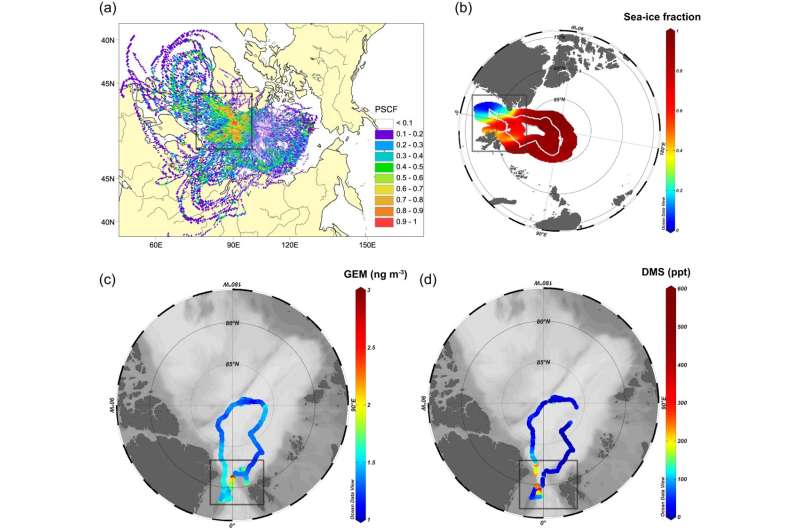This article has been reviewed according to Science X's editorial process and policies. Editors have highlighted the following attributes while ensuring the content's credibility:
fact-checked
peer-reviewed publication
trusted source
proofread
Researchers reveal dominant source of atmospheric mercury in the Arctic

A research team led by Prof. Xie Zhouqing and Prof. Le Fange from the University of Science and Technology of China (USTC) of the Chinese Academy of Sciences (CAS) revealed that the Marginal Ice Zone (MIZ) is a dominant source of atmospheric gaseous elemental mercury (GEM), and proposed a mechanism for the summertime peak of GEM in the Arctic. Their work was published in Nature Communications.
GEM is a highly toxic pollutant that can be transported over long distances via atmospheric circulation. Mercury will enter the aquatic food chain after being methylated by microorganisms, which will endanger the ecological environment.
The Arctic plays an important role in the mercury cycling process and is also a sensitive area for mercury exposure. Previous studies have found that atmospheric GEM in the Arctic has a unique seasonal variation with a deficit in spring and a peak in summer, and that its average summer concentration exceeds the northern hemisphere background level. However, the source and driving mechanism of summertime GEM maximum is still controversial.
During the Multidisciplinary drifting Observatory for the Study of Arctic Climate (MOSAiC), the research team conducted a one-year observation of GEM in the Arctic Ocean using a cold vapor atomic fluorescence spectroscopic Hg analyzer Tekran 2537 and constructed a generalized additive model (GAM) to analyze the summertime data.
The results showed that more than 63% of the GEM variations can be explained by the GAM. Anthropogenic and land-based emissions contribute no more than 2% of the variations, while oceanic evasion contribute more than 52%, which is the dominant factor of the summertime GEM variations in the Arctic Ocean.
The potential source contribution function (PSCF) analysis revealed that the oceanic evasion during summertime mainly occurs in the MIZ. Hg evasion flux in the MIZ was estimated to be 56 ng m-2 day-1, which is more than twice the flux in the Arctic open ocean.
Through multidisciplinary analysis of the observational data, the team proposed the driving mechanism of the Hg evasion in the MIZ.
The springtime atmospheric Hg depletion events (AMDEs) caused a large amount of atmospheric GEM to be oxidized and deposited on the sea-ice surface. These deposited Hg was then transferred to the MIZ with snow and sea-ice melt during summertime, largely increasing the divalent Hg load in the MIZ.
A large number of organic compounds produced during summertime significantly facilitated the photoreduction of divalent Hg to elemental Hg, which were easily exchanged between sea and air. The melting of sea ice in the MIZ and the disappearance of the meltwater layer promote the release of elemental Hg in seawater to the atmosphere through the air-sea interface, making the MIZ an important source of the atmospheric GEM peak in the Arctic during summertime.
This study revealed the impact of sea ice changes in the Arctic on Hg cycling processes, providing a scientific basis for the risk assessment of Hg exposure to polar organisms and populations.
More information: Fange Yue et al, The Marginal Ice Zone as a dominant source region of atmospheric mercury during central Arctic summertime, Nature Communications (2023). DOI: 10.1038/s41467-023-40660-9
Journal information: Nature Communications
Provided by Chinese Academy of Sciences

















